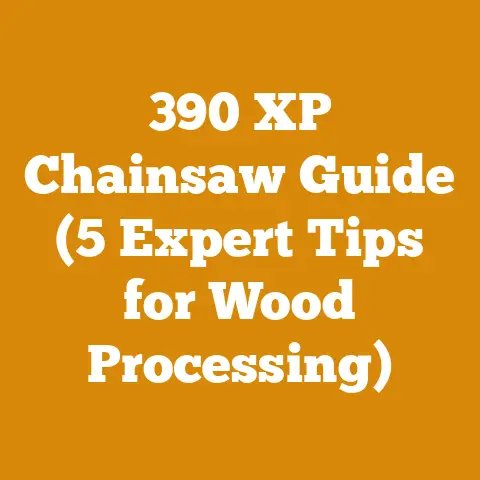V Belt vs Cog Belt in Wood Processing (Essential Gear Insights)
Let’s bust a myth right off the bat: All belts are created equal. That’s simply not true, especially when we’re talking about the guts of our wood processing machinery. The choice between a V-belt and a cog belt (also known as a notched belt) can significantly impact your efficiency, power, and the lifespan of your equipment. I’ve seen firsthand how a seemingly small decision like this can make or break a logging operation. Over the years, I’ve learned a thing or two about what works and what doesn’t, and I’m here to share that with you.
V-Belt vs. Cog Belt in Wood Processing: Essential Gear Insights
Choosing the right belt for your wood processing equipment isn’t just about slapping on whatever fits. It’s about understanding the nuances of each type, their strengths, weaknesses, and how they perform under the demanding conditions of wood processing. I’ll walk you through everything you need to know.
Understanding V-Belts
V-belts are the workhorses of power transmission. Their trapezoidal shape fits snugly into a similarly shaped groove on a pulley, using friction to transfer power.
How They Work: The “V” shape increases the contact area between the belt and the pulley, maximizing friction and preventing slippage.
Advantages of V-Belts:
- Cost-Effective: V-belts are generally cheaper than cog belts. This makes them an attractive option for budget-conscious operations. I remember a time when I was just starting out and every penny counted. V-belts were a lifesaver.
- Wide Availability: You can find V-belts in almost any size and configuration at most auto parts stores or industrial supply houses. This makes replacements quick and easy.
- Good for General Use: They perform well in a variety of applications where precise timing isn’t critical.
- Shock Absorption: V-belts offer a decent amount of shock absorption. This can help protect your equipment from sudden impacts or overloads.
Disadvantages of V-Belts:
- Slippage: Slippage is a common issue, especially under heavy loads or in damp conditions. This reduces efficiency and can generate heat, leading to premature wear. I’ve seen slippage cause serious problems with sawmill operations, leading to inconsistent cuts and wasted wood.
- Lower Efficiency: Due to slippage, V-belts are less efficient than cog belts, typically around 90-95%.
- Heat Buildup: The friction from slippage generates heat, which can degrade the belt material and shorten its lifespan.
- Less Precise Timing: V-belts aren’t ideal for applications where precise timing is essential, as slippage can cause inconsistencies.
When to Use V-Belts:
- Light to Medium Duty Applications: They are well-suited for applications like powering fans, pumps, and light-duty conveyors.
- Cost-Sensitive Projects: If your budget is tight and precision isn’t paramount, V-belts can be a viable option.
- Equipment with Built-In Slip Tolerance: Some machines are designed to tolerate a certain amount of belt slippage without affecting performance.
Real-World Example:
I once used V-belts on a small firewood processor I built from scratch. It worked well for processing smaller logs, but when I tried to tackle larger, denser hardwoods, the belts would slip, causing the hydraulic system to bog down. I eventually switched to cog belts, which made a huge difference.
Takeaway: V-belts are a good starting point for many applications, but be aware of their limitations, especially when dealing with heavy loads or demanding conditions.
Understanding Cog Belts (Notched Belts)
Cog belts, also known as notched belts, have teeth or cogs that mesh with corresponding grooves on the pulleys. This positive engagement eliminates slippage and provides more efficient power transmission.
How They Work: The cogs ensure a direct, positive connection between the belt and the pulley, preventing slippage and maintaining consistent speed.
Advantages of Cog Belts:
- No Slippage: The primary advantage of cog belts is their ability to eliminate slippage. This results in more efficient power transfer and consistent performance.
- Higher Efficiency: Cog belts are significantly more efficient than V-belts, often exceeding 98% efficiency.
- Improved Heat Dissipation: The cogs allow for better airflow around the belt, reducing heat buildup and extending its lifespan.
- Precise Timing: Cog belts are ideal for applications where precise timing is critical, such as driving saw blades or synchronizing multiple machine components.
- Reduced Maintenance: Due to their superior performance and durability, cog belts typically require less maintenance than V-belts.
Disadvantages of Cog Belts:
- Higher Cost: Cog belts are generally more expensive than V-belts. This can be a significant factor for budget-conscious operations.
- Less Shock Absorption: Cog belts offer less shock absorption than V-belts. This means they are more susceptible to damage from sudden impacts or overloads.
- More Sensitive to Misalignment: Proper alignment is crucial for cog belts. Misalignment can cause premature wear and failure.
- Can Be Noisier: Some cog belts can be noisier than V-belts, especially at high speeds.
When to Use Cog Belts:
- Heavy-Duty Applications: Cog belts are ideal for demanding applications like powering sawmills, log splitters, and other heavy machinery.
- High-Precision Operations: If precise timing and consistent speed are essential, cog belts are the way to go.
- High-Efficiency Requirements: When maximizing power transfer and minimizing energy waste is crucial, cog belts offer a clear advantage.
- Extreme Environments: Cog belts are more resistant to heat, oil, and other contaminants, making them suitable for harsh operating conditions.
Real-World Example:
I upgraded the belts on my sawmill from V-belts to cog belts, and the difference was night and day. The saw blade ran smoother, the cuts were more consistent, and I noticed a significant reduction in power consumption. It was a worthwhile investment.
Takeaway: Cog belts are the superior choice for demanding applications where efficiency, precision, and reliability are paramount. While they cost more upfront, their long-term benefits often outweigh the initial investment.
Key Differences Summarized
To make things clearer, here’s a table summarizing the key differences between V-belts and cog belts:
| Feature | V-Belt | Cog Belt (Notched Belt) |
|---|---|---|
| Cost | Lower | Higher |
| Efficiency | 90-95% | 98%+ |
| Slippage | Prone to slippage | No slippage |
| Timing | Less precise | Highly precise |
| Heat Buildup | Higher | Lower |
| Shock Absorption | Better | Less |
| Maintenance | More frequent | Less frequent |
| Noise | Quieter | Can be noisier |
| Applications | Light to medium duty | Heavy-duty, high-precision |
Factors to Consider When Choosing a Belt
Selecting the right belt involves considering several factors specific to your wood processing equipment and operating conditions.
1. Horsepower Requirements:
- Lower Horsepower (Under 10 HP): V-belts may be sufficient for lighter applications.
- Higher Horsepower (10 HP and Above): Cog belts are generally recommended for their superior power transfer capabilities.
2. Speed Requirements:
- Low to Moderate Speeds: V-belts can perform adequately at lower speeds.
- High Speeds: Cog belts are better suited for high-speed applications where slippage is a concern.
3. Operating Environment:
- Clean, Dry Environments: V-belts can work well in controlled environments.
- Dusty, Oily, or Hot Environments: Cog belts are more resistant to contaminants and heat, making them a better choice for harsh conditions.
4. Pulley Size and Configuration:
- Smaller Pulleys: V-belts may be necessary for smaller pulleys due to their flexibility.
- Larger Pulleys: Cog belts can be used with larger pulleys for maximum power transfer.
5. Budget Constraints:
- Tight Budget: V-belts offer a more affordable initial investment.
- Long-Term Cost Savings: Cog belts can save money in the long run due to their higher efficiency and reduced maintenance.
6. Machine Design:
- Existing Pulley Grooves: Ensure the belt type is compatible with the existing pulley grooves.
- Tensioning System: Consider the type of tensioning system available and whether it is suitable for the chosen belt type.
Example Scenario:
Imagine you’re setting up a small sawmill powered by a 20 HP engine. The sawmill will be operating in a dusty environment and requires precise blade speed for consistent cuts. In this scenario, a cog belt would be the clear choice due to its high power transfer efficiency, resistance to contaminants, and ability to maintain precise timing.
Actionable Metric:
Track the number of hours your equipment operates before requiring belt replacement. Compare the lifespan of V-belts versus cog belts to determine which offers a better return on investment for your specific application.
Belt Materials and Construction
The material and construction of a belt play a significant role in its performance and durability.
V-Belt Materials:
- Rubber: The most common material for V-belts, offering a good balance of flexibility and strength.
- Polyurethane: More durable and resistant to chemicals than rubber, but also more expensive.
- Wrapped Belts: Feature a fabric cover that protects the core material from wear and tear.
- Raw Edge Belts: Have exposed edges for better grip and heat dissipation.
Cog Belt Materials:
- Reinforced Rubber: Typically made from high-strength rubber reinforced with fibers like aramid or fiberglass.
- Aramid Fiber (Kevlar): Offers exceptional strength and heat resistance, making it ideal for heavy-duty applications.
- Polychain: A type of synchronous belt made from polyurethane with steel or aramid cords for high power transmission and durability.
Construction Techniques:
- Molded Cogs: Cog belts with molded cogs offer precise tooth profiles and consistent performance.
- Cut Cogs: Cog belts with cut cogs are more flexible and can be used with smaller pulleys.
Material Selection Guide:
| Material | Advantages | Disadvantages | Applications |
|---|---|---|---|
| Rubber | Cost-effective, flexible | Less durable, susceptible to heat and oil | Light to medium-duty V-belts |
| Polyurethane | Durable, chemical-resistant | More expensive | Specialty V-belts, harsh environments |
| Aramid Fiber | High strength, heat-resistant | More expensive, less flexible | Heavy-duty cog belts, high-temperature applications |
| Polychain | High power transmission, durable | Most expensive | Synchronous drives, high-performance machinery |
Expert Tip:
When selecting a belt material, consider the specific demands of your application. For example, if you’re operating in a hot environment, choose a belt made from heat-resistant materials like aramid fiber or polychain.
Case Study:
A logging operation in the Pacific Northwest experienced frequent belt failures on their debarker due to the high moisture content and abrasive nature of the bark. They switched from standard rubber V-belts to aramid fiber cog belts, which significantly reduced downtime and increased the lifespan of the belts by over 300%.
Takeaway:
Choosing the right belt material is crucial for maximizing performance and longevity. Consider the operating environment, load requirements, and budget when making your selection.
Installation and Maintenance
Proper installation and maintenance are essential for ensuring the longevity and performance of your belts.
V-Belt Installation:
- Inspect Pulleys: Check the pulleys for wear, damage, and proper alignment.
- Loosen Tension: Loosen the tensioning system to allow for easy belt installation.
- Install Belt: Place the belt over the pulleys, ensuring it sits properly in the grooves.
- Adjust Tension: Adjust the tension according to the manufacturer’s specifications. Use a belt tension gauge for accurate measurements.
- Check Alignment: Use a straightedge or laser alignment tool to ensure the pulleys are properly aligned.
- Run-In Period: Run the equipment at a reduced speed for a short period to allow the belt to seat properly.
Cog Belt Installation:
- Inspect Pulleys: Ensure the pulley grooves are clean and free of debris.
- Align Pulleys: Proper alignment is critical for cog belts. Use a laser alignment tool for precise adjustments.
- Install Belt: Place the belt over the pulleys, ensuring the cogs mesh properly with the grooves.
- Adjust Tension: Adjust the tension according to the manufacturer’s specifications. Over-tensioning can damage the belt and pulleys.
- Check Timing: Verify that the timing marks on the pulleys are aligned correctly, if applicable.
- Run-In Period: Run the equipment at a reduced speed for a short period to allow the belt to seat properly.
Maintenance Tips:
- Regular Inspections: Inspect belts regularly for signs of wear, cracking, or damage.
- Tension Adjustments: Check and adjust belt tension periodically, especially during the first few hours of operation.
- Cleanliness: Keep belts and pulleys clean and free of debris.
- Proper Storage: Store belts in a cool, dry place away from direct sunlight and chemicals.
- Replacement: Replace belts when they show signs of excessive wear or damage.
Tensioning Guidelines:
- V-Belt Tension: The proper tension should allow for slight deflection when pressed midway between the pulleys. A general rule of thumb is to allow for 1/64 inch of deflection per inch of span length.
- Cog Belt Tension: Cog belts require more precise tensioning. Use a belt tension gauge to measure the tension in pounds or Newtons, according to the manufacturer’s specifications.
Troubleshooting:
- Belt Slippage: Check belt tension and pulley alignment. Replace worn belts.
- Belt Noise: Check pulley alignment and belt tension. Lubricate pulleys if necessary.
- Premature Wear: Check pulley alignment, belt tension, and operating environment. Use a higher-quality belt material if necessary.
Actionable Metric:
Implement a monthly belt inspection checklist to identify potential problems early. Track the frequency of belt replacements and analyze the causes of failure to identify areas for improvement.
Takeaway:
Proper installation and maintenance are crucial for maximizing the lifespan and performance of your belts. Regular inspections, tension adjustments, and cleanliness are essential for preventing premature wear and failure.
Specific Applications in Wood Processing
Let’s dive into some specific wood processing applications and see which belt type is best suited for each.
1. Sawmills:
- Main Saw Drive: Cog belts are the preferred choice for the main saw drive due to their high power transfer efficiency and ability to maintain precise blade speed.
- Log Feed System: Cog belts can also be used for the log feed system to ensure consistent and accurate log advancement.
- Hydraulic Pumps: V-belts may be sufficient for powering hydraulic pumps, depending on the horsepower requirements.
2. Log Splitters:
- Hydraulic Pump Drive: Cog belts are recommended for driving the hydraulic pump in log splitters due to their ability to handle heavy loads and maintain consistent hydraulic pressure.
3. Firewood Processors:
- Log Infeed Conveyor: V-belts can be used for the log infeed conveyor, depending on the size and weight of the logs.
- Saw Blade Drive: Cog belts are essential for the saw blade drive to ensure precise and efficient cutting.
- Hydraulic System: Cog belts are preferred for driving the hydraulic system, especially in high-volume processors.
4. Wood Chippers:
- Chipper Rotor Drive: Cog belts are the best choice for driving the chipper rotor due to their ability to handle high horsepower and impact loads.
- Infeed System: V-belts may be used for the infeed system, depending on the size and type of material being chipped.
5. Debarkers:
- Debarker Rotor Drive: Cog belts are recommended for the debarker rotor drive due to their resistance to moisture and abrasive materials.
Application-Specific Recommendations:
| Application | Recommended Belt Type | Rationale |
|---|---|---|
| Sawmill Main Drive | Cog Belt | High power transfer, precise blade speed, consistent cuts |
| Log Splitter Pump | Cog Belt | Handles heavy loads, maintains consistent hydraulic pressure |
| Firewood Processor Saw | Cog Belt | Precise and efficient cutting, high-volume processing |
| Wood Chipper Rotor | Cog Belt | High horsepower, impact loads, resistance to debris |
| Debarker Rotor | Cog Belt | Resistance to moisture and abrasive materials |
Real-World Example:
A firewood processing operation in Maine upgraded their processor from V-belts to cog belts on the saw blade drive. They saw an immediate increase in production speed and a reduction in blade slippage, resulting in more consistent firewood lengths and a significant improvement in overall efficiency.
Takeaway:
Choosing the right belt type for each specific application is crucial for maximizing performance and minimizing downtime. Consider the load requirements, operating environment, and precision needs of each machine component.
Safety Considerations
Safety should always be a top priority when working with wood processing equipment. Belts and pulleys can be hazardous if not handled properly.
General Safety Guidelines:
- Lockout/Tagout: Always use lockout/tagout procedures before performing any maintenance or repairs on equipment.
- Guards: Ensure all belts and pulleys are properly guarded to prevent accidental contact.
- Personal Protective Equipment (PPE): Wear appropriate PPE, including safety glasses, gloves, and hearing protection.
- Training: Ensure all operators are properly trained on the safe operation and maintenance of equipment.
- Emergency Stop: Familiarize yourself with the location and operation of the emergency stop buttons.
Specific Safety Tips for Belts and Pulleys:
- Never Adjust Belts While Equipment is Running: Always shut down and lock out the equipment before making any adjustments to belts or pulleys.
- Keep Hands and Clothing Away: Keep hands, clothing, and hair away from moving belts and pulleys.
- Inspect Belts Regularly: Inspect belts regularly for signs of wear or damage. Replace worn or damaged belts immediately.
- Use Proper Tools: Use the proper tools for installing and tensioning belts.
- Avoid Over-Tensioning: Over-tensioning belts can cause premature wear and failure, as well as damage to pulleys and bearings.
Emergency Procedures:
- Belt Failure: If a belt fails, immediately shut down the equipment and lock it out. Inspect the equipment for damage and replace the belt before resuming operation.
- Entanglement: If someone becomes entangled in a belt or pulley, immediately shut down the equipment and call for emergency assistance.
Safety Checklist:
- [ ] Lockout/Tagout procedures in place
- [ ] Belts and pulleys properly guarded
- [ ] Operators trained on safe operation
- [ ] Emergency stop buttons accessible
- [ ] Regular belt inspections performed
- [ ] Proper tools used for maintenance
Case Study:
Takeaway:
Safety should always be a top priority when working with wood processing equipment. Follow all safety guidelines and procedures to prevent accidents and injuries.
Cost Analysis: V-Belt vs. Cog Belt
Let’s break down the costs associated with each belt type to help you make an informed decision.
V-Belt Costs:
- Initial Cost: Lower initial purchase price.
- Replacement Frequency: More frequent replacements due to wear and slippage.
- Maintenance Costs: Higher maintenance costs due to frequent adjustments and inspections.
- Energy Costs: Higher energy consumption due to lower efficiency.
- Downtime Costs: Potential downtime due to belt failures and slippage.
Cog Belt Costs:
- Initial Cost: Higher initial purchase price.
- Replacement Frequency: Less frequent replacements due to durability and efficiency.
- Maintenance Costs: Lower maintenance costs due to less frequent adjustments and inspections.
- Energy Costs: Lower energy consumption due to higher efficiency.
- Downtime Costs: Reduced downtime due to fewer belt failures and slippage.
Cost Comparison Table:
| Cost Factor | V-Belt | Cog Belt |
|---|---|---|
| Initial Purchase | Lower | Higher |
| Replacement | More Frequent | Less Frequent |
| Maintenance | Higher | Lower |
| Energy Consumption | Higher | Lower |
| Downtime | Higher Risk | Lower Risk |
Example Cost Calculation:
Let’s assume you have a sawmill that requires a belt replacement every 6 months with a V-belt costing $50 each time. Over 3 years, you’ll spend $300 on belts alone.
Now, let’s say a cog belt for the same sawmill costs $150 but lasts for 3 years. In this case, you’ll only spend $150 over the same period.
In addition to the cost savings on belts, you’ll also save on maintenance and energy consumption with the cog belt.
Return on Investment (ROI):
To calculate the ROI, consider the total cost of ownership over a specific period. The formula is:
ROI = (Total Savings – Initial Investment) / Initial Investment
Actionable Metric:
Track the total cost of ownership for each belt type over a 3-5 year period. Include the cost of belts, maintenance, energy consumption, and downtime. Calculate the ROI to determine which belt type offers the best value for your operation.
Takeaway:
While cog belts have a higher initial cost, they often offer a better return on investment in the long run due to their durability, efficiency, and reduced maintenance requirements.
Future Trends in Belt Technology
The world of belt technology is constantly evolving, with new materials and designs emerging to improve performance and efficiency.
Emerging Trends:
- Advanced Materials: Development of new materials like carbon fiber and advanced polymers for increased strength, heat resistance, and flexibility.
- Smart Belts: Integration of sensors and monitoring systems to track belt tension, wear, and temperature in real-time.
- Self-Tensioning Systems: Automated tensioning systems that maintain optimal belt tension without manual adjustments.
- Wireless Monitoring: Wireless communication of belt performance data to remote monitoring systems for predictive maintenance.
- Energy-Efficient Designs: New belt designs that minimize friction and energy loss for improved efficiency.
Impact on Wood Processing:
These advancements will have a significant impact on the wood processing industry, leading to:
- Increased Efficiency: Higher power transfer and reduced energy consumption.
- Reduced Downtime: Predictive maintenance and early detection of potential problems.
- Improved Safety: Real-time monitoring of belt conditions to prevent failures and accidents.
- Lower Operating Costs: Reduced maintenance and replacement costs.
Expert Prediction:
In the next 5-10 years, we’ll see a widespread adoption of smart belts and self-tensioning systems in the wood processing industry. These technologies will enable operators to optimize belt performance and minimize downtime, leading to significant cost savings and improved safety.
Takeaway:
Stay informed about the latest trends in belt technology to take advantage of new innovations that can improve the efficiency, safety, and cost-effectiveness of your wood processing operation.
Conclusion: Making the Right Choice for Your Needs
Choosing between a V-belt and a cog belt for your wood processing equipment is a decision that shouldn’t be taken lightly. It’s about understanding your specific needs, considering the factors I’ve outlined, and making an informed choice that aligns with your budget, performance requirements, and safety priorities.
I’ve shared my experiences, insights, and practical advice to help you navigate this decision. Remember, there’s no one-size-fits-all answer. It’s about finding the right balance between cost, efficiency, and reliability for your unique operation.
So, take the time to assess your needs, weigh the pros and cons of each belt type, and make a choice that will help you achieve your goals. Whether you’re a small-scale firewood producer or a large-scale sawmill operator, the right belt can make a significant difference in your productivity and profitability.






